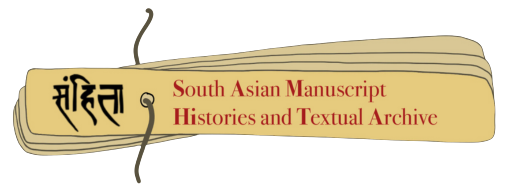Manuscripts
Search Filter
Pītāmbarasahasranāmastotra
EAP1023/17/1 Language : Sanskrit Scripts : Devanagari
Bagalamukhi is known by the popular epithet Pitambara-devi or Pitambari. She wears yellow clothes. The iconography and worship rituals repeatedly refer to the yellow colour. Pitamvara Sahasranama Stotra is the eulogy of Baglamukhi.This text is Bagalamukhi Stotra that recites.
Rasamaňjarī
EAP1023/28/8 Language : Sanskrit Scripts : Devanagari
Sanskrit classic Rasamanjari, a long poem with epical stretch but not an epic, is a work by the known Sanskrit poet Bhanudatta. It is a 15th century text on Indian aesthetics. This is an erotic text. Rasamanjari literally refers to the cluster of blossoms full of Rasas. It is one of the most inspiring texts of ancient India that prompted various schools of Indian painting.
Tristhalīsetu
EAP1023/28/5 Language : Sanskrit Scripts : Devanagari
This is text known as Marana Mukti Vichara in Sanskrit. Literally, it is idea of liberation after death. It is written by Narayana Bhatta. This is the Gaya Prakarana section of the text.
Laghusiddhāntakaumudī
EAP1023/28/6 Language : Sanskrit Scripts : Devanagari
Laghusiddhāntakaumudī by Varadarāja (1600-1650) son of Durgātanaya, disciple of Bhaṭṭoji Dīkṣita. From its title it is easy to understand that this text was wrote as an elementary text for Sanskrit learners.
Vidhānapārijāta
EAP1023/28/2 Language : Sanskrit Scripts : Devanagari
This text is the book of marriage rituals. This is the third chapter of the text.
Bṛhatsaṃhitā
EAP1023/25/53 Language : Sanskrit Scripts : Devanagari
Vrihat Samhita is authored by Varaha Mihira. The Brihat-Samhita by Varaha Mihira is an encylopedia of wide ranging subjects of human interest, including astrology, planetary movements, eclipses, rainfall, clouds, architecture, growth of crops, matrimony, domestic relations, gems, pearls and rituals. It contains one hundred and six chapters. This text is the Magnum Opus of Varaha Mihira.
Dānamayūkha
EAP1023/25/52 Language : Sanskrit Scripts : Devanagari
Dana Mayukha is authored by Nilakantha Bhatta. It is one of his twelve Mayukhas. Mayukha literally means 'Ray of Light'. The twelve Mayukhas of Nilakantha Bhatta are Samskara Mayukha, Acara Mayukha, Samaya Mayukha, Suddhi Mayukha, Niti Mayukha, Vyavahara Mayukha, Dana Mayukha, Utsarga Mayukha, Pratistha Mayukha, Shraddha Mayukha, Prayaschitta Mayukha, and Shanti Mayukha.
Kriyā Yoga Sāra
EAP1023/25/50 Language : Sanskrit Scripts : Devanagari
The Kriya Yoga Sara is always considered as a sort of supplement to the Padma Purana, or as a portion of the Uttara Khanda of that Purana. It is divided into twenty five chapters and 4000 stanzas.
Māghamāhātmya
EAP1023/25/49 Language : Sanskrit Scripts : Devanagari
Magha Mahatmya is glorification of the holy month of Magha. This story is contained in the Padmapurāṇa in the form of dialogue between Vashistha and Dilipa.
Purarścaryārṇava
EAP1023/25/51 Language : Sanskrit Scripts : Devanagari
This text is written by King Pratap Singh Shah of Nepal. He ruled Nepal in the eighteenth century. He was devout Tantric practitioner. This is Tantra Shastra Vidhana Paddhati.
Padmapurāṇa - Sr̥ṣtī Khaṇḍa
EAP1023/25/47 Language : Sanskrit Scripts : Devanagari
Padma Purana exists in two different recensions, Bengal and the West Indian versions. Bengal recension consists of five sections: Shrishti Khanda, Bhumi Khanda, Svarga Khanda, Patala Khanda and Uttara Khanda. The Patala Khanda of this recension contains thirty-one additional chapters. This is the Shristi Khanda.
Kāśī Māhātmyam
EAP1023/25/48 Language : Sanskrit Scripts : Devanagari
This manuscript if the glorification of Kashi, the holliest place in Northern India. This is the manuscript of Kashi Mahatmya contained in the pātālakhaṇḍa of the Padmapurāṇa.













